本篇文章为大家展示了怎么在Java中实现哈希表,内容简明扼要并且容易理解,绝对能使你眼前一亮,通过这篇文章的详细介绍希望你能有所收获。一、哈希表头插法放入元素public class HashBuck {&nb
本篇文章为大家展示了怎么在Java中实现哈希表,内容简明扼要并且容易理解,绝对能使你眼前一亮,通过这篇文章的详细介绍希望你能有所收获。
public class HashBuck { class node { public int key; int value; Node next; Node(int key, int value) { this.key = key; this.value = value; } } public int usedSize; public Node[] array; HashBuck() { this.array = new Node[8]; this.usedSize = 0; } //jdk1.7及之前是头插法 public void put1(int key, int value) { int index = key % this.array.length; Node node = new Node(key, value); Node cur = array[index]; while (cur != null) { if (cur.key == key) { cur.value = value; return; } cur = cur.next; } node.next = array[index]; array[index] = node; this.usedSize++; if (loadFactor() > 0.75) { resize1(); } } public double loadFactor() { return this.usedSize / this.array.length * 1.0; }}//JDK1.8是尾插法 public Node findLast(Node head) { if (head == null) return head; Node cur = head; while (cur.next != null) { cur = cur.next; } return cur; } public void put2(int key, int value) { int index = key % this.array.length; Node node = new Node(key, value); Node cur = array[index]; while (cur != null) { if (cur.key == key) { cur.value = value; return; } cur = cur.next; } Node last = findLast(array[index]); if (last == null) { array[index] = node; this.usedSize++; return; } last.next = node; this.usedSize++; if (loadFactor() > 0.75) { resize2(); } }public void resize1() { Node[] newArray = new Node[this.array.length * 2]; for (int i = 0; i < this.array.length; i++) { Node cur = array[i]; while (cur != null) { int index = cur.key % newArray.length; Node curNext = cur.next; cur.next = newArray[index]; newArray[index] = cur; cur = curNext; } } this.array = newArray; } //resize尾插 public void resize2() { Node[] newArray = new Node[this.array.length * 2]; for (int i = 0; i < this.array.length; i++) { Node cur = array[i]; while (cur != null) { int index = cur.key % newArray.length; Node curNext = cur.next; Node last = findLast(newArray[index]); if (last == null) { newArray[index] = cur; break; } last.next = cur; cur = curNext; } } this.array = newArray; } public Node findLast(Node head) { if (head == null) return head; Node cur = head; while (cur.next != null) { cur = cur.next; } return cur; } public int get(int key) { int index = key % this.array.length; Node cur = this.array[index]; while (cur != null) { if (cur.key == key) { return cur.value; } cur = cur.next; } return -1; }class HashBuckTest { public static void main(String[] args) { HashBuck hashBuck = new HashBuck(); //头插 hashBuck.put1(9,451); hashBuck.put1(17,455); //尾插 //hashBuck.put2(9,451); //hashBuck.put2(17,455); hashBuck.put1(2,45); hashBuck.put1(3,14); hashBuck.put1(4,52); hashBuck.put1(4,89); System.out.println(hashBuck.get(1)); System.out.println("+================="); }}头插
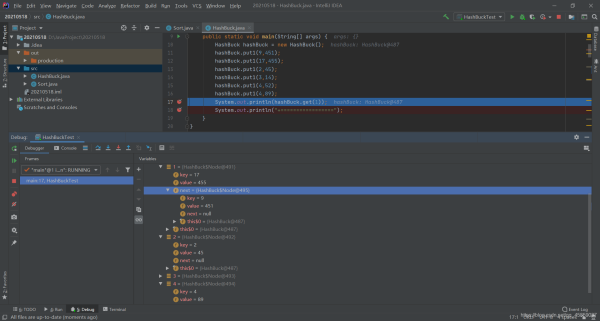
尾插
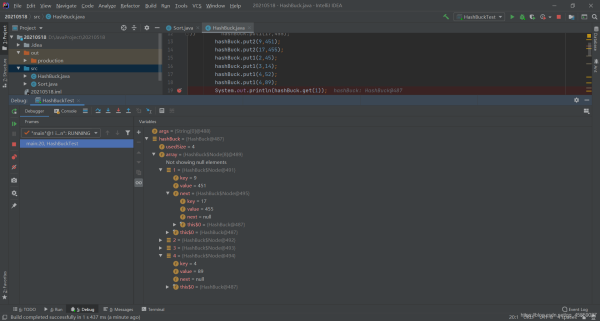
扩容
class HashBuckTest { public static void main(String[] args) { HashBuck hashBuck = new HashBuck();// hashBuck.put1(9, 451);// hashBuck.put1(17, 455); hashBuck.put1(1, 589); hashBuck.put1(2, 45); hashBuck.put1(3, 14); hashBuck.put1(4, 52); hashBuck.put1(4, 1); hashBuck.put1(6, 829); hashBuck.put1(7, 72); hashBuck.put1(8, 8279); hashBuck.put2(9,451); hashBuck.put2(15,455); hashBuck.put2(31,451); System.out.println(hashBuck.get(7)); System.out.println(hashBuck.get(4)); System.out.println(hashBuck.get(15)); System.out.println(hashBuck.get(31)); }}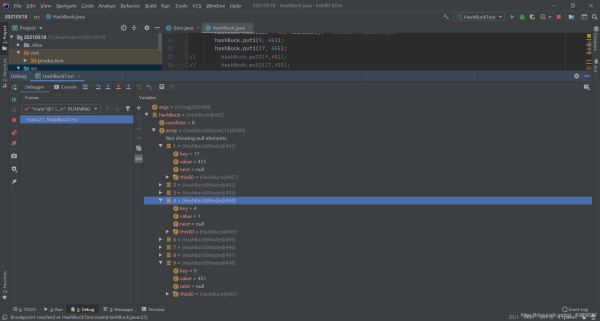
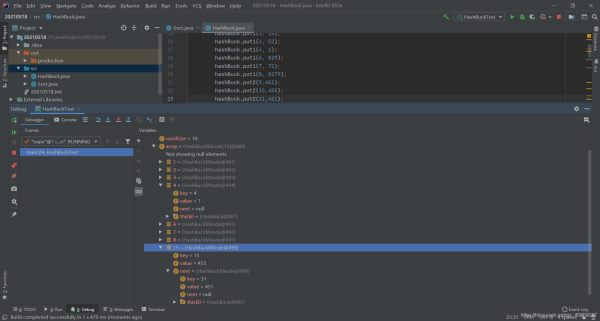
get

public class HashBuck2<K, V> { static class Node<K, V> { public K key; public V val; public Node<K, V> next; public Node(K key, V val) { this.key = key; this.val = val; } } public Node<K, V>[] array; public int usedSize; public HashBuck2() { this.array = (Node<K, V>[]) new Node[8]; } public void put(K key, V val) { int hash = key.hashCode(); int index = hash % array.length; Node<K, V> cur = array[index]; while (cur != null) { if (cur.key.equals(key)) { cur.val = val; return; } cur = cur.next; } Node<K, V> node = new Node<>(key, val); node.next = array[index]; array[index] = node; this.usedSize++; if (loadFactor() > 0.75) { resize(); } } public V get(K key) { int hash = key.hashCode(); int index = hash % array.length; Node<K, V> cur = array[index]; while (cur != null) { if (cur.key.equals(key)) { return cur.val; } cur = cur.next; } return null; } public void resize() { Node[] newArray = new Node[this.array.length * 2]; for (int i = 0; i < this.array.length; i++) { Node<K,V> cur = array[i]; while (cur != null) { int hash = cur.key.hashCode(); int index = hash % array.length; Node <K,V>curNext = cur.next; cur.next = newArray[index]; newArray[index] = cur; cur = curNext; } } this.array = newArray; } public double loadFactor() { return this.usedSize / this.array.length * 1.0; }}class Student{ public int id; Student(int id){ this.id = id; } @Override public boolean equals(Object o) { if (this == o) return true; if (o == null || getClass() != o.getClass()) return false; Student student = (Student) o; return id == student.id; } @Override public int hashCode() { return Objects.hash(id); }}class HashBuck2Test{ public static void main(String[] args) { HashBuck2<Student,Integer> hashBuck2 = new HashBuck2<>(); Student s1 = new Student(10001); Student s2 = new Student(10001); Student s3 = new Student(10003); hashBuck2.put(s1,89); hashBuck2.put(s1,60); hashBuck2.put(s2,94); hashBuck2.put(s3,100); System.out.println(hashBuck2.get(s1)); System.out.println(hashBuck2.get(s2)); }}注意:
要用自定义类作为 HashMap 的 key 或者 HashSet 的值,必须覆写 hashCode 和 equals 方 法,而且要做到 equals 相等的对象,hashCode 一定是一致的。
比如Student s1 和 s2 的id一样,得到的却是不同的value,所以要覆写hashCode 和 equals 方 法,如果不覆写,则使用的是Object类的hashCode 和 equals 方 法,比较的是地址。
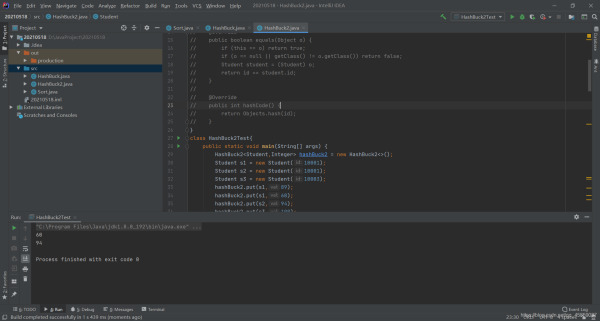
重写之后
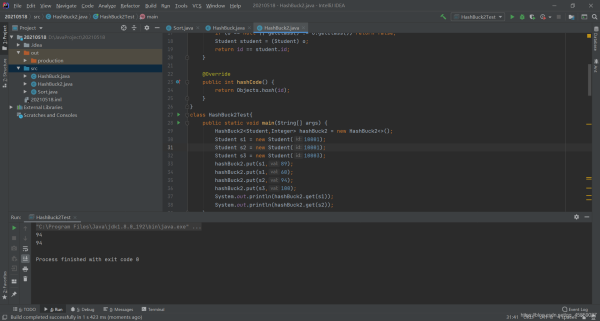
1.springMVC,spring WEB mvc是一种基于Java的实现了Web MVC设计模式的请求驱动类型的轻量级Web框架。2.shiro,Apache Shiro是Java的一个安全框架。3.mybatis,MyBatis 是支持普通 sql查询,存储过程和高级映射的优秀持久层框架。4.dubbo,Dubbo是一个分布式服务框架。5.Maven,Maven是个项目管理和构建自动化工具。6.RabbitMQ,RabbitMQ是用Erlang实现的一个高并发高可靠AMQP消息队列服务器。7.Ehcache,EhCache 是一个纯Java的进程内缓存框架。
上述内容就是怎么在Java中实现哈希表,你们学到知识或技能了吗?如果还想学到更多技能或者丰富自己的知识储备,欢迎关注编程网精选频道。
--结束END--
本文标题: 怎么在Java中实现哈希表
本文链接: https://lsjlt.com/news/277668.html(转载时请注明来源链接)
有问题或投稿请发送至: 邮箱/279061341@qq.com QQ/279061341
2024-05-24
2024-05-24
2024-05-24
2024-05-24
2024-05-24
2024-05-24
2024-05-24
2024-05-24
2024-05-24
2024-05-24
回答
回答
回答
回答
回答
回答
回答
回答
回答
回答
0